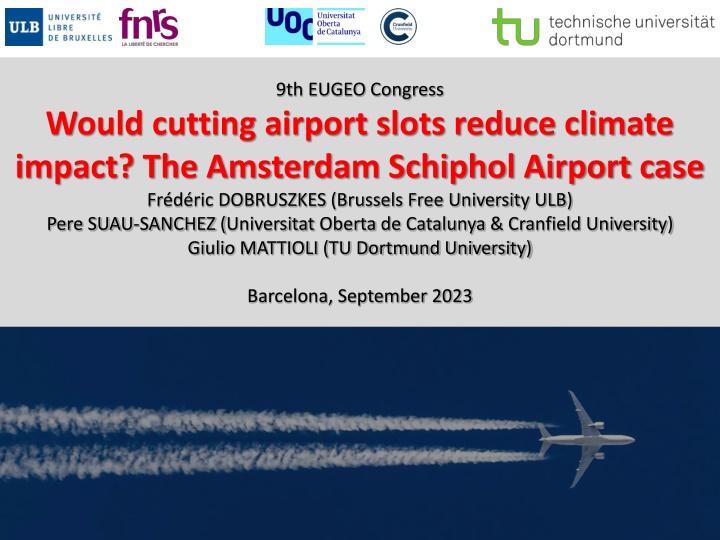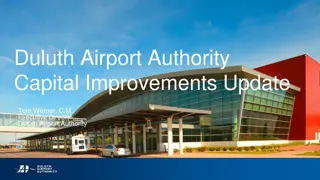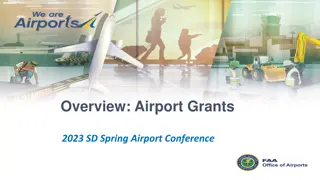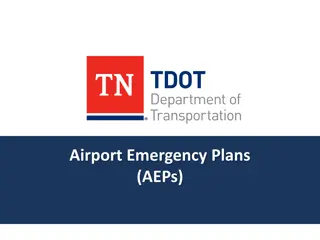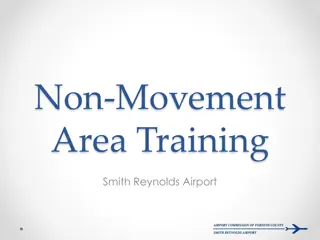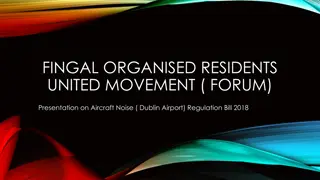Reducing Airport Slots for Climate Impact: Amsterdam Schiphol Case
Aviation is a significant contributor to greenhouse gas emissions, with non-CO2 effects often overlooked. The case study of Amsterdam Schiphol Airport explores the potential climate benefits of cutting airport slots and the implications for reducing environmental impact.
Uploaded on Feb 26, 2025 | 2 Views
Download Presentation

Please find below an Image/Link to download the presentation.
The content on the website is provided AS IS for your information and personal use only. It may not be sold, licensed, or shared on other websites without obtaining consent from the author.If you encounter any issues during the download, it is possible that the publisher has removed the file from their server.
You are allowed to download the files provided on this website for personal or commercial use, subject to the condition that they are used lawfully. All files are the property of their respective owners.
The content on the website is provided AS IS for your information and personal use only. It may not be sold, licensed, or shared on other websites without obtaining consent from the author.
E N D
Presentation Transcript
9th EUGEO Congress Would cutting airport slots reduce climate impact? The Amsterdam Schiphol Airport case Fr d ric DOBRUSZKES (Brussels Free University ULB) Pere SUAU-SANCHEZ (Universitat Oberta de Catalunya & Cranfield University) Giulio MATTIOLI (TU Dortmund University) Barcelona, September 2023
Introduction 2 Aviation and climate change Quick facts: Aviation is a fast-growing source of greenhouse gas (GHG) emissions Non-CO2 effects are often neglected but would account for 2/3 of aviation s climate impact although with uncertainties (Lee et al., 2021) Virtually none serious alternative to kerosene in the short/medium terms (Peeters et al., 2016; G ssling and Lyle, 2021) Gains in energy efficiency offered by new aircraft are more than offset by traffic increase (Dobruszkes & Ibrahim, 2022)
Introduction 3 In short, there are two key options: Techno-optimism (typical green capitalism approach) Curbing no. of flights and/or distance flown (involves regulatory reforms and/or taxation, mostly an unquestioned taboo) In the real world: Many airports are engaged in capacity extension, particularly outside Europe Emerging countries also build new airports Air traffic and thus aviation-driven climate change are globally growing except during main crises
Introduction 4 The Amsterdam Airport (AMS) case: One of the largest Europe s airports by various metrics Global hub of Dutch carrier KLM and partners Noise pollution issues for a long time despite several efforts Main departure routes from AMS https://www.schiphol.nl/en/schiphol-as-a-neighbour/page/is-my-house-underneath-a-flight-path/
Introduction 5 The Amsterdam Airport (AMS) case: The Dutch government intends to restrict the number of slot to 440,000 (from 500,000), which will prevent going back to pre-Covid levels Rationale: Meeting local noise regulations However, climate change is explicitly cited as an indirect benefit
Introduction 6 Today s goal Assessing the potential climate benefit of slot reduction at AMS having in mind that GHG emissions of one single flight are a function of aircraft type (and weight) and of the distance flown (key geographical parameter) The longer a flight is, the greater the amount of fuel is burnt Source : based on Seymour et al., 2020
Introduction > Methodology 7 Data and methods 2019 passenger flights (OAG) updated to 2024 Several scenarios with various distance mix given its strong influence on fuel burnt and thus GHG emissions Fuel as a proxy for GHG emissions and climate impact; based on quadratic equations proposed by Seymour et al. (2020) Source : based on Seymour et al., 2020
Introduction > Methodology 8 Scenarios Key data S1 2024 Baseline S2A GOV S2B DIST S2C RAIL S3 SCHIPHOL S4 EQUAL DISTANCE S5 LONG- DISTANCE Movements demand 493,728 493,728 493,728 493,728 493,728 493,728 493,728 Mov. Limits 500,000 440,400 440,400 440,400 460,400 440,400 440,400 Slot reduction None 60,000 60,000 60,000 40,000 60,000 60,000 Commercial passenger flight reduction None 52,188 52,188 52,188 32,761 52,188 52,188 Reduction strategy None Slot pro rata then shortest distances Shortest distances flown Shortest rail travel times Slot pro rata then shortest distances Slot pro rata, all distances equally affected Slot pro rata then shortest distances flown flown flown + 10,000 extra short flights turned into long-haul
Introduction > Methodology 9 Scenarios Reduction strategies Step-1: Pro-rata slot reduction allocation. We follow the principle defined by the Worldwide Airport Slot Board (WASB): all airlines affected by reductions in airport capacity must be impacted in the same proportion (WASB, 2020). However, applying a fixed proportion to each carrier s frequencies to find the number of slots to reduce for each creates rounding issues, i.e., carriers with small numbers of frequencies might be too over-impacted when rounded up or the opposite when rounded down. We use the well-known D Hont method (or greatest divisor method) to solve this. This method will find the whole-number distribution of slots to reduce closest to exact proportionality. Step-2: Airline slot reduction strategy. Once each airline has a defined number of slots to reduce, it can distribute them across its flight offering using different criteria (e.g., distance, competition with other modes, etc.). This allows us to create hypothetical scenarios.
Introduction > Methodology 10 Scenarios Distance mix
Introduction > Methodology > Results 11 Results S1 2024 Baseline S2A GOV S2B DIST S2C RAIL S3 SCHIPHOL S4 EQUAL DISTANCE S5 LONG- DISTANCE Movements demand 493,728 493,728 493,728 493,728 493,728 493,728 493,728 Mov. Limits 500,000 440,400 440,400 440,400 460,400 440,400 440,400 Slot reduction None 60,000 60,000 60,000 40,000 60,000 60,000 Commercial passenger flight reduction None 52,188 52,188 52,188 32,761 52,188 52,188 Reduction strategy None Slot pro rata then shortest distances Shortest distances flown Shortest rail travel times Slot pro rata then shortest distances Slot pro rata, all distances equally affected Slot pro rata then shortest distances flown flown flown Short-term fuel gains are limited ( 11% at best) Short-term fuel gains are always smaller than slot cut ( 12%) + 10,000 extra short flights turned into long-haul Fuel burnt departing comm. pass. flights (ktonnes) 2,695 2,552 2,649 2,645 2,607 2,401 3,062 Change REF 5.3% 1.7% 1.8% 3.2% 10.9% +13.6%
Introduction > Methodology > Results 12 Results
Introduction > Methodology > Results 13 Results
Introduction > Methodology > Results 14 Results
Introduction > Methodology > Results 15 Results
Introduction > Methodology > Results 16 Results
Introduction > Methodology > Results > Conclusions 17 Conclusions 1. Notwithstanding potential favourable impacts on noise pollution, slot reduction would offer limited short-term benefits for climate change. 2. Climate benefits are even smaller when slot reduction only/mostly affects short-haul flights (most plausible scenario) 3. If a significant share of remaining slots is reallocated to long-haul flights, climate impact of AMS could even increase despite the 60,000-slot cut Confirms the tyranny of the distance flown in aviation climate change issues 4. Long-term effects depend on traffic leakage to alternative airports (both in the Netherlands and global hubs abroad), and up-gauging and destination selectivity behaviour by airlines Call for global policies
9th EUGEO Congress Would cutting airport slots reduce climate impact? The Amsterdam Schiphol Airport case Fr d ric DOBRUSZKES (Brussels Free University ULB) Pere SUAU-SANCHEZ (Universitat Oberta de Catalunya & Cranfield University) Giulio MATTIOLI (TU Dortmund University) Barcelona, September 2023 QUESTIONS?
Backup slide 19 FUEL EFFICIENCY ABSOLUTE FUEL BURNT Shorter flights are inefficient The longer a flight is, the greater the amount of fuel is burnt
